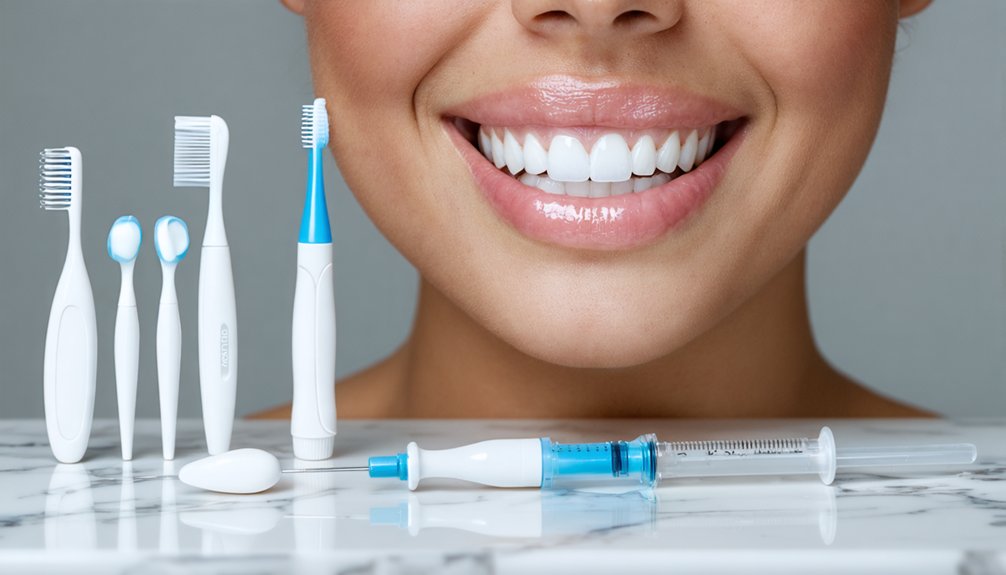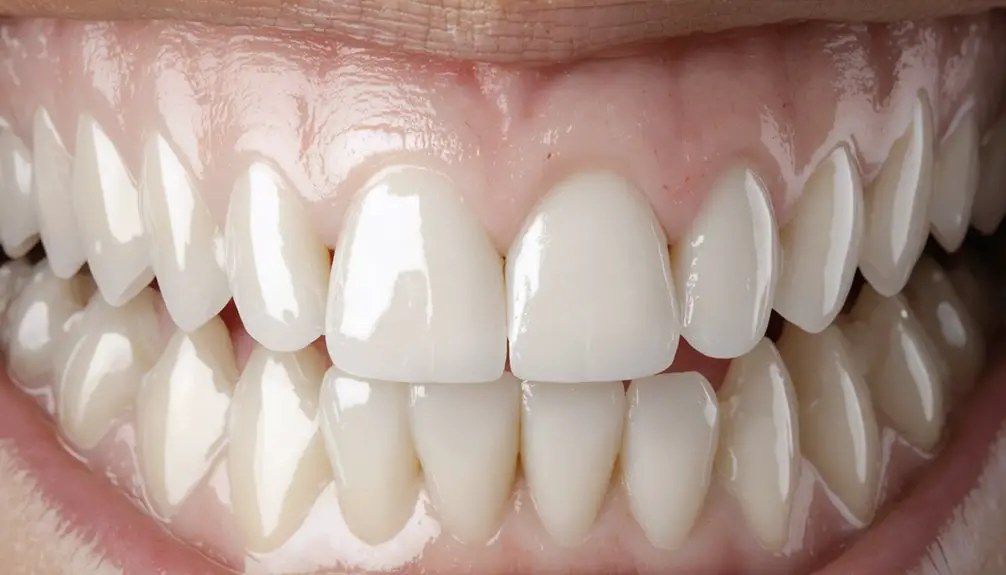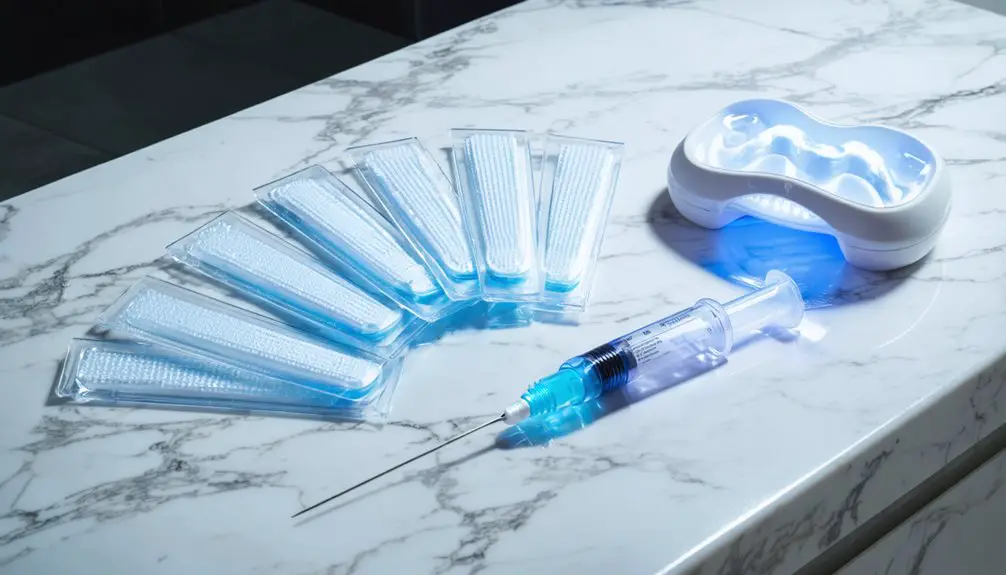For sensitive teeth, you’ll find several effective whitening options that minimize discomfort while delivering results. Professional treatments offer customized trays with desensitizing agents and precise application protocols. Over-the-counter products containing lower peroxide concentrations (5-6%) combined with potassium nitrate and fluoride can safely brighten your smile. Pre-treatment with desensitizing toothpaste 1-2 weeks before whitening greatly reduces sensitivity. Understanding your specific sensitivity level will help determine the most suitable approach for achieving your desired outcome.
Key Takeaways
- Professional treatments with custom-fitted trays provide optimal safety and effectiveness while minimizing gum exposure and sensitivity risks.
- Using desensitizing toothpaste 1-2 weeks before whitening treatment significantly reduces discomfort during the whitening process.
- Sensitivity-safe whitening strips with 5-6% peroxide concentration offer gradual results when used in short, 5-minute daily applications.
- Whitening gels containing potassium nitrate and fluoride help block nerve pain while providing gentle yet effective stain removal.
- Professional fluoride treatments strengthen enamel and provide protection against sensitivity when combined with whitening procedures.
Understanding Tooth Sensitivity and Whitening
While tooth sensitivity affects a notable portion of the global population, with prevalence rates ranging from 4% to 74%, it presents unique challenges for those seeking teeth whitening treatments.
If you’re experiencing tooth sensitivity, you’re likely dealing with exposed dentinal tubules that communicate pain signals to your tooth’s nerve endings when stimulated by temperature changes or chemicals.
Understanding your dental care needs is vital, as sensitivity often indicates underlying issues like enamel erosion, gum recession, or periodontal disease. Research shows that dental erosion signs appear in 98% of individuals with sensitivity. Many patients experience increased sensitivity when breathing cold air through their mouths during winter months.
Addressing dental sensitivity is crucial, as it may signal serious oral health concerns requiring professional attention before cosmetic treatments.
Studies show that women are more prone to sensitivity than men, with 56% of females reporting symptoms.
Since sensitivity can persist for over two years and considerably impact your daily life, it’s important to address these concerns before pursuing any whitening treatments that might exacerbate discomfort.
Professional Dental Whitening Treatments
Professional whitening treatments begin with your dentist taking impressions to create custom-fitted trays that guarantee precise application and minimize gum exposure to whitening agents.
Patients with tooth sensitivity should consult their dentist first since pre-existing sensitivity can worsen during treatment.
In-office treatments provide rapid results under clinical supervision, allowing your dentist to monitor sensitivity and adjust concentrations accordingly. These treatments use powerful bleaching agents that are more effective than store-bought alternatives while incorporating protective measures.
Prior to treatment, you’ll receive desensitizing agents and protective barriers to reduce discomfort while maintaining peak whitening efficacy.
Custom-Fitted Trays Process
For patients with sensitive teeth, custom-fitted whitening trays represent a precise and controlled approach to professional teeth whitening. Your dental professional will perform a thorough sensitivity assessment prior to treatment.
The custom tray benefits include minimized gum exposure, uniform gel distribution, and the ability to adjust treatment duration based on sensitivity levels. The special trays are designed from detailed impressions to ensure optimal coverage while protecting gum tissue. Your dentist will create exact molds of your teeth using digital scanning or putty impressions, ensuring ideal fit and effectiveness during treatment sessions.
- Professional-grade whitening gels contain higher concentrations of peroxide while maintaining comfort through custom reservoirs.
- Treatment sessions typically range from 30 minutes to several hours daily, adjustable to your sensitivity threshold.
- Tray maintenance requires thorough cleaning after each use to preserve longevity and effectiveness.
- Custom trays remain viable for years, allowing periodic touch-ups without additional dental visits.
In-Office Treatment Benefits
In-office dental whitening treatments represent the gold standard for patients with sensitive teeth, combining advanced technology with professional oversight to achieve ideal results.
Among the key in-office advantages is the ability to customize treatment protocols based on individual sensitivity levels, allowing dentists to adjust gel concentrations and exposure times as needed.
Professional whitening systems like Philips ZOOM® incorporate specialized desensitizing agents and light-activation technology, maximizing effectiveness while minimizing discomfort. Special numbing medication options are available to further enhance patient comfort during whitening sessions. Regular dental check-ups ensure the ongoing safety and effectiveness of whitening treatments.
Treatment customization extends to real-time monitoring, enabling immediate intervention if sensitivity occurs.
You’ll benefit from precise application methods that prevent gum irritation and eliminate risks associated with ill-fitting trays.
Additionally, the controlled clinical environment guarantees proper pre-treatment screening and allows for gradual, multi-session approaches when necessary, delivering optimal results while protecting sensitive teeth.
Desensitizing Pre-Treatment Options
Before initiating professional teeth whitening treatments, implementing thorough desensitizing pre-treatment protocols substantially reduces discomfort and enhances treatment outcomes. Discussing sensitivity concerns beforehand with your dentist ensures the most appropriate pre-treatment approach.
The desensitizing toothpaste benefits are significant when you begin use 1-2 weeks prior to treatment, as potassium nitrate and fluoride actively block neural pathways causing sensitivity. Fluoride treatment effectiveness is maximized through professional application, strengthening your enamel and creating a protective barrier against whitening agents. A professional calcium phosphate treatment can help remineralize weakened enamel areas before beginning the whitening process.
- Apply desensitizing agents in-office immediately before treatment to calm nerve responses
- Use custom-fitted trays with integrated desensitizing gels for precise application
- Avoid acidic foods, hot/cold beverages, and alcohol 1-2 weeks before treatment
- Continue using prescribed desensitizing products throughout your whitening process for sustained comfort
Gentle Over-the-Counter Solutions
When seeking over-the-counter whitening solutions for sensitive teeth, you’ll find that strips and gels with lower peroxide concentrations provide gradual yet effective results while minimizing discomfort.
Products like Crest 3D Whitestrips Sensitive incorporate desensitizing agents that help block nerve signals during the whitening process.
You can optimize your results by selecting products containing potassium nitrate and fluoride while avoiding those with harsh abrasives like hydrated silica.
Low-Concentration Whitening Strips
Low-concentration whitening strips represent a viable solution for individuals with sensitive teeth seeking gentle teeth whitening treatment. These products contain 5-6% peroxide concentrations, considerably lower than professional treatments, while still delivering effective results through consistent use.
You’ll find these strips particularly beneficial if you’ve experienced discomfort with higher-concentration options.
- Apply strips for shorter durations (around 5 minutes) to minimize sensitivity risk
- Use daily for two weeks to achieve gradual, comfortable whitening
- Monitor your teeth’s response and stop if considerable sensitivity occurs
- Maintain room temperature beverage consumption during treatment periods
The low concentration effectiveness balances whitening outcomes with comfort, making these strips suitable for sensitive teeth.
When comparing peroxide levels, these gentler formulations offer eight times less risk of triggering dentin hypersensitivity while still providing noticeable whitening results.
Sensitivity-Safe Gel Products
Specially formulated for sensitive teeth, over-the-counter whitening gels offer a gentler approach to teeth whitening through reduced peroxide concentrations and protective ingredients.
These sensitivity-safe formulations typically contain 6% hydrogen peroxide, equivalent to 18% carbamide peroxide, which breaks down safely into oxygen and water.
You’ll find these gels enhanced with soothing ingredients like potassium nitrate to block nerve pain signals and fluoride to strengthen enamel.
Natural additives such as aloe vera and peppermint oil provide additional comfort during treatment.
Application methods have been optimized with precise applicators and shorter treatment times of about 2 minutes per use.
Clinical research supports that these gentler formulations can achieve noticeable whitening results within 14 days while minimizing sensitivity risks when used as directed.
Sensitivity-Friendly Whitening Toothpastes
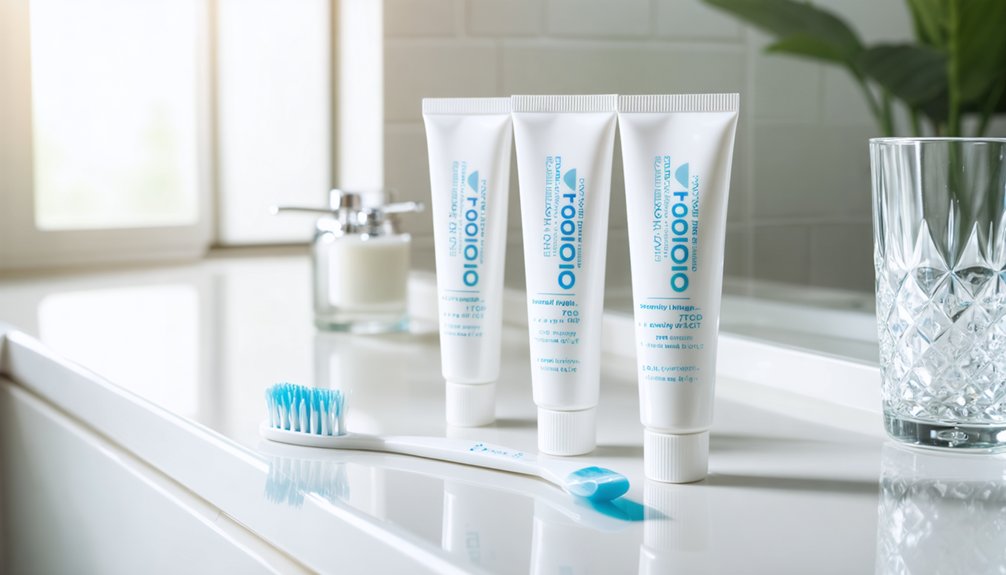
People with tooth sensitivity can now benefit from advanced whitening toothpastes specifically formulated to brighten teeth while minimizing discomfort.
Key toothpaste ingredients like potassium nitrate work by blocking nerve signals that cause sensitivity, while gentle whitening agents such as baking soda effectively remove surface stains without harsh abrasion.
Clinical studies show these specialized formulations can deliver noticeable whitening results while protecting vulnerable teeth.
- Potassium nitrate provides 24-hour sensitivity relief by calming nerve endings
- Low-abrasion formulas with baking soda safely lift stains while preserving enamel
- Fluoride strengthens teeth and reduces post-whitening sensitivity
- SLS-free options prevent additional irritation common with traditional whitening products
When comparing effectiveness, sensitivity-friendly whitening toothpastes offer gradual but reliable results for those who can’t tolerate stronger bleaching treatments.
Natural and Alternative Whitening Methods
While many patients seek natural alternatives to chemical whitening treatments, the scientific evidence supporting these methods remains limited for those with sensitive teeth.
Among natural remedies, oil pulling shows minimal documented whitening effects, though it’s generally safe for daily use.
Your best approach focuses on preventive dietary choices and proper oral hygiene. Include water, dairy products, and fibrous fruits in your diet while avoiding stain-causing beverages like coffee and red wine.
Regular, gentle brushing and professional cleanings can help maintain whiteness without compromising sensitive teeth.
Be cautious with trending DIY methods – activated charcoal, acidic fruits, and baking soda pastes can damage enamel and worsen sensitivity.
Traditional herbal remedies lack clinical validation for both safety and efficacy.
Managing Discomfort During Treatment
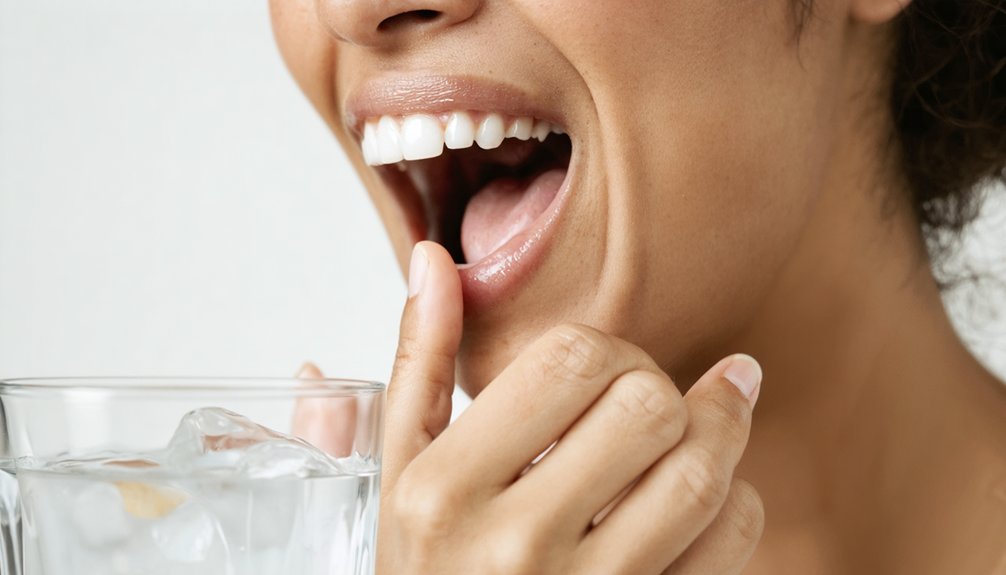
Managing sensitivity during teeth whitening requires a thorough pre-treatment strategy and careful monitoring throughout the process.
To guarantee your comfort, dental professionals employ specialized sensitivity management techniques, including customized trays and lower concentration gels. You’ll benefit from controlled application methods that protect your enamel while achieving desired results.
- Start desensitizing treatments 1-2 weeks before whitening with potassium nitrate or fluoride products
- Use custom-fitted trays with buffering agents to minimize gum irritation and nerve sensitivity
- Maintain consistent temperature during treatment to prevent nerve stimulation
- Apply protective coatings between sessions to strengthen enamel and reduce discomfort
These comfort techniques, combined with professional guidance, help minimize sensitivity while maximizing whitening effectiveness.
Your dentist will adjust treatment protocols based on your individual needs and sensitivity levels.
Long-Term Maintenance Strategies
Successful teeth whitening results depend on implementing effective long-term maintenance strategies after your initial treatment.
Start using desensitizing toothpaste containing potassium nitrate at least a week before whitening and continue indefinitely. This proactive approach helps block exposed dentin tubules and reduces nerve sensitivity.
Your dietary modifications play an essential role in protecting enamel integrity. Limit acidic foods and beverages while increasing consumption of calcium-rich options like yogurt and leafy greens.
Schedule professional fluoride treatments every 3-6 months to sustain enamel remineralization and prevent sensitivity relapse. When continuing whitening treatments, extend intervals between sessions and consider lower peroxide concentrations.
These evidence-based maintenance protocols will help preserve your results while managing sensitivity for ideal long-term outcomes.
Prevention and Safety Tips
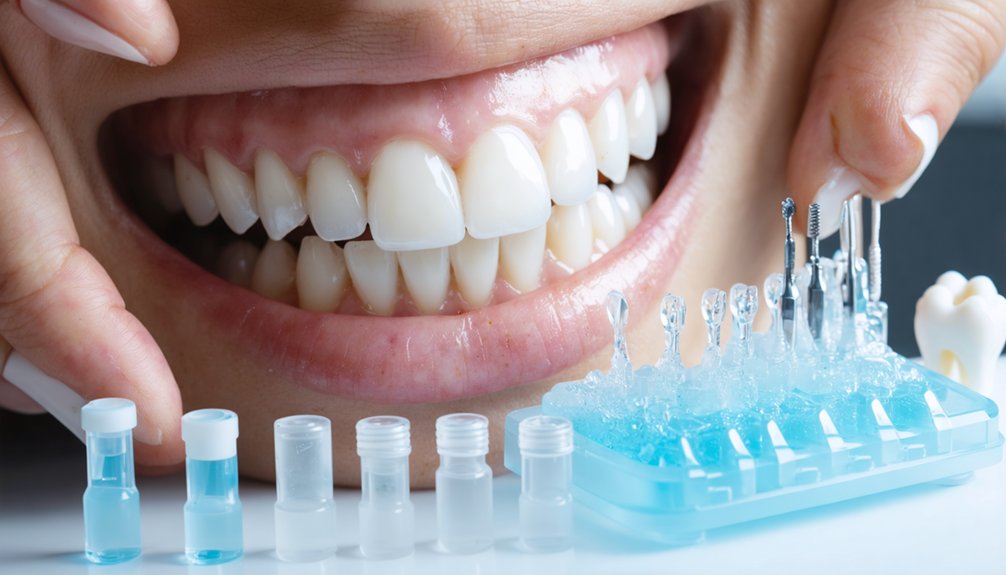
Because teeth whitening carries inherent risks for those with sensitive teeth, implementing proper safety protocols becomes crucial for successful treatment.
You’ll need to carefully monitor sensitivity triggers and maintain appropriate whitening frequency to protect your dental health. Professional consultation before beginning any whitening regimen guarantees customized treatment plans that minimize discomfort and maximize results.
- Always conduct a patch test with new whitening products to assess potential sensitivity reactions
- Select products specifically formulated for sensitive teeth, containing less than 10% hydrogen peroxide
- Follow manufacturer’s instructions precisely, avoiding overexposure to bleaching agents
- Monitor for adverse reactions like burning sensations or gum irritation, discontinuing use immediately if they occur
Remember to maintain consistent communication with your dental professional throughout your whitening journey to adjust protocols as needed.
Frequently Asked Questions
How Long Should I Wait Between Professional Whitening Treatments?
Your teeth will practically scream for mercy if you whiten too often! You should maintain treatment intervals of 6-12 months between professional whitening frequency to protect enamel health and minimize sensitivity risks.
Can Certain Medications Affect Teeth Whitening Results for Sensitive Teeth?
Your medications can greatly impact whitening effectiveness and increase sensitivity. Antibiotics, antihistamines, and antihypertensives often cause discoloration and may require modified treatment approaches to achieve desired results.
Are There Age Restrictions for Whitening Treatments on Sensitive Teeth?
You shouldn’t undergo teeth whitening treatments if you’re under 14-16 years old. Safe whitening practices and regulations strongly recommend waiting until permanent teeth fully develop to prevent damage to sensitive teeth.
Does Insurance Typically Cover Professional Whitening for Sensitive Teeth?
Picture your wallet staying full – insurance coverage typically won’t include whitening costs for sensitive teeth since it’s considered cosmetic. You’ll need to plan for out-of-pocket expenses for professional treatment.
Can Pregnancy Impact Sensitivity During Teeth Whitening Procedures?
Yes, pregnancy hormones greatly increase tooth sensitivity during whitening procedures. You’ll experience heightened discomfort due to enhanced gum inflammation, enamel changes, and increased blood flow to oral tissues.
References
- https://www.redrocksfamilydentistry.com/teeth-whitening-options-for-sensitive-teeth/
- https://www.sensodyne.com/en-us/oral-health-tips/whitening-sensitive-teeth/what-to-know/
- https://www.44thstdental.com/how-to-whiten-sensitive-teeth/
- http://www.goochlanddentistry.com/whats-the-best-teeth-whitener-for-sensitive-teeth/
- https://www.goodrx.com/conditions/dental-care/sensitive-teeth-after-whitening
- https://www.drbobsdentalcare.com/is-teeth-whitening-safe-for-sensitive-teeth/
- https://pmc.ncbi.nlm.nih.gov/articles/PMC4058574/
- https://www.ada.org/resources/ada-library/oral-health-topics/whitening
- https://pmc.ncbi.nlm.nih.gov/articles/PMC7448347/
- https://pmc.ncbi.nlm.nih.gov/articles/PMC11326452/
